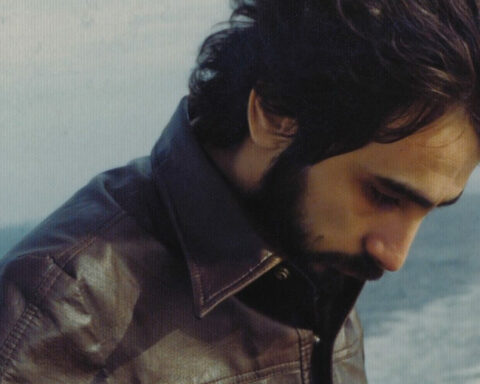Where to begin?
In short, there are a great many documentaries in the Vancouver International Film Festival (VIFF for those that know her well). Some 72 shorts, features and installations. They’re clumped into different sections, and sprinkled like raisins throughout the program, popping up in new manifestations like VR (Virtual Reality) and AR, which stands for Augmented Reality. But really, isn’t that what documentary is all about, taking the real world, and adding some structure and form to this meandering, confusing mass of experience we call life?
Get out your knife and fork, and let’s dig in, shall we.
The more high profile films are frontloaded into the Gala section with Jennifer Baichwal, Nicholas de Pencier, and Edward Burtynsky’s ANTHROPOCENE: The Human Epoch and the late Rob Stewart’s Sharkwater Extinction leading the pack. One of the most celebrated documentaries from the previous year, Brett Morgen’s Jane receives an encore screening with the woman herself, as part of a special evening in support of the Jane Goodall Institute of Canada. Expect a great many emotional breakdowns brought on by the “the Jane Effect,” a term used to describe people bursting into tears at the mere sight of famed primatologist. Being a secular saint must be something of a burden, but as Morgen’s film makes clear, it was ever thus. The moment the world caught its first glimpse Goodall in the jungles of Tanzania, it went, if you’ll pardon the term, completely bananas. Following the screening, Dr. Goodall will speak about her life’s work, and I expect that many people will let loose. Let the tears roll down the aisles, and honking and howling fill the theatre. We’re all primates, after all.
Sharkwater Extinction and ANTHROPOCENE are also given prominent slots at the Festival, but to be frank, they’re some of the weaker films on offer. Sharkwater in particular is unfocused, choppy, and seemingly scraped together into something that is barely a story. To be fair, Stewart died in the middle of the production, and this reality casts a grim light over the action. The film also suffers from what I would call the cult of personality, in which the filmmaker wildly overshadows their subject.
ANTHROPOCENE is a much better film than Sharkwater, but it contains exactly what you expect, namely stunning photographic imagery, overwhelming in scale and scope, with grave narration supplied by Alicia Vikander. It’s beautiful and horrifying in equal measure, but also strangely passive, floating over blighted devastated sections of the planet, gnawed at by machines of Brobdingnagian size. Occasionally, the omniscient camera lands on the ground, and pads around talking to human-size people. Some of these folks are more interesting than others. Workers in the remote Siberian city of Norilsk aren’t too forthcoming, and in the Chilean Atacama Desert, another worker talks about the value of lithium like he’s reading a prepared statement from a kidnapper. Much more emotionally engaging are scenes of ivory burning in Kenya that bookend the action.
After a while, the journey around from the globe — from Australia’s Great Barrier Reef to the forests of British Columbia — starts to feel like the greatest hits version of environmental devastation. Coral bleaching! Clear cutting! And more! There’s also terraforming, open-pit mining, and everyone’s favourite, mass extinction. The solemnity starts to be feel suffocating. Yes, we know things are grim, but can we have a moment of levity now and then? Since the release of Manufactured Landscapes (2006), and Watermark (2013), a number of other films have droned over the same turf. (Velcrow Ripper and Nova Ami’s film Metamorphosis does something quite similar.) While, ANTHROPOCENE is interesting to look at, the information isn’t new, or shocking any longer. Environmental catastrophe is commonplace, ubiquitous even. I attended a screening of the film expecting to be overwhelmed and devastated, but I didn’t feel anything at all. Which is also kind of horrifying in its own way.
If you’re looking for a film with genuine emotional impact, you’re better off wandering a little further afield into dedicated sections such M/A/D, which stands for music, art, design, and not what happens when you stand in a rush line for last minute tickets. M/A/D contains a number of lovely films, beginning with La Divina, that’s Maria Callas to all you barbarians out there. Tom Volf’s portrait Maria by Callas wears its heart on its sleeve, but in the case of Callas that is entirely right and appropriate. The woman inspired a form of devotion that has rarely been rivalled in the operatic universe. While other sopranos like Joan Sutherland or the megalodon that was Birgit Nilsson were technically better singers, they lacked Callas’s astounding ability to embody the larger-than-life heroines she played on stage. One need only witness her portrayal of Tosca stabbing the evil chief of police Scarpia to death, after he tries to rape her, to remember that above all, Callas was a titanic, and sometimes terrifying, performer.
The other selections in M/A/D could also stand for music, art and dudes. There are a number of outsize men here, beginning with The Eyes of Orson Welles, and carrying on with Ingmar Bergman. Street photography legend Garry Winogrand gets a documentary portrait in Garry Winogrand: All Things Are Photographable. There’s also Blue Note Records: Beyond the Notes, Bathtubs Over Broadway, and Minute Bodies: The Intimate Lives of F. Percy Smith, in which newt sex figures prominently. Men and their various obsessions – be they newts, women, or guitars – are lovingly detailed throughout. In Ron Mann’s Carmine Street Guitars, a great many men, and the occasional guitar god buzz around Rick Kelly’s store in Greenwich Village, noodling away on various instruments.
Men being monstrous might be another subtitle for the section, and principal among these is no other than Old Man Bergman himself. Jane Magnusson’s film Bergman: A Year in the Life confines itself to the year 1957, when apparently Bergman was not only engaged in creating six major masterpieces but also found time to father a bunch of children, use and abuse copious amounts of women, all the while largely subsisting on a diet of dry biscuits. While you digest this fact and wonder about the contents of the biscuits, other outsize folks crowd in. Nathaniel Kahn’s film The Price of Everything documents the unsavoury intermingling of contemporary art and major money. It is something of a chin dropper, to put it mildly; even Hitler, or at least a facsimile of him, puts in an appearance. As the artists, dealers, collectors, and curators circle and snarl, all clutching glasses of wines at auctions, biennales, and upscale galleries, art becomes somewhat secondary to the money paid for it.
Money also plays a key role in Marco Proserpio’s The Man Who Stole Banksy, which is pretty much exactly what the title says. A section of wall in Palestine that bears the work of the famous, and mysterious Mr. B is chiselled out and sent into the art market, all with the help of a fixer/taxi driver named Walid Zawahrah. All holy hell breaks loose.
Money makes people do crazy things, and also wear crazy things. And nothing quite outdoes the fashion world for sheer lunacy. To wit: Pïetra Brettkelly’s film Yellow is Forbidden that charts the rise of designer Guo Pei and her million dollar dresses. Pei rocketed to global fame on the back of the 16-foot train of Rihanna’s infamous omelette gown at the 2015 Met Ball. It was the yolk heard round the world, but the image of fashion gone riotously over the top is at odds with the woman at the centre of the style storm. Pei herself, is a rather quiet soul, although scenes of her berating her atelier workers to sew faster and cheaper makes it clear she is no pushover. When she goes up against the fashion establishment in the heady climes of the Parisian haut couture world, the real claws come out. Jungle red, naturally.
Money, along with a hefty slathering of sex and drugs, provides the fuel for Matt Tyrnauer’s Studio 54, a rather indulgent romp through the disco Mecca in the raw and raunchy ‘70s, when everyone was apparently doing everyone else in the infamous balconies and bathrooms of the joint. So much so that when they redesigned the club, they made it easier to sluice down certain sections, where people were humping and bumping to the disco beat.
A slightly more wholesome film about dance is Laetitia Carton’s Le Grand Bal, wherein French people prove that they’re sexier than everyone else in the world. The action takes place in the village of Gennetines, where for seven sultry days and sweaty nights, legions of dancers get funky. Or Le Funkée, as I believe it is pronounced. The film is deeply charming, and may convince anyone, young or old, fit or infirm, that dancing is life, and vice versa.
After all that sweaty sexy stuff you may need a breather, or at least a quieter, and more introspective film. Jill Magid’s The Proposal may be just the ticket, as it follows the circuitous and insanely passive aggressive relationship that springs up between two women over a dead architect. It’s a slow burn, but strangely fascinating in its own fashion, not unlike the architecture of Luis Barragán, the character at the centre of the drama.
Another chamber piece is Connie Field’s The Whistleblower of My Lai that charts the creation of an opera based upon the life and times of Hugh Thompson, an American pilot, who reported the infamous massacre, and paid the price for calling out his fellow soldiers. Thompson is a fascinating figure, but the opera production is a little less so. As the composer, the singers, and the Kronos Quartet rehearse, the story of American soldiers murdering more than 500 civilians in the waning days of the Vietnam conflict, gets somewhat lost. Still, there is a great deal to be appreciated here, especially Thompson’s courage, immortalized in song.
For the hardcore documentary fans, there’s an ample supply of oatmeal-variety films collected under the banner of Impact. The term itself makes me think about hitting people in the back of the head, and shouting “It’s good for you!” They’re not always the most tasty or fun, but if “Uncompromising films and insightful discussions” sounds like your bowl of hot oats, then have at ‘er. It’s a strong selection, tripping along from Lola Aria’s Theatre of War to Vladimir Putin giving face in Vitaly Mansky’s Putin’s Witnesses. More curious iterations like Sean Devlin’s documentary hybrid When the Storm Fades, or Roberto Minervini’s What You Gonna Do When the World’s On Fire? are stuffed into different categories such as Panorama’s Vanguard, described as a collection of films “Just slightly ahead the curve.” Which sounds like they rounded a corner too fast and went spinning off into space. Which is not entirely inaccurate.
There’s still more. Canadian, and in particular filmmakers from BC are well-represented at VIFF with new work from directors Grant Baldwin (This Mountain Life), Kathleen Jayme (Finding Big Country), Cody Graham, Carey Newman (Picking Up the Pieces: The Making of the Witness Blanket), Kim O’Bomsawin (Quiet Killing), Astra Taylor (What Is Democracy?), and Christy Garland (What Walaa Wants) all waving the maple leaf in a grand showing of patriotic documentary pride.
More on these films shortly!
Although there are a few famous faces at VIFF such as Abel Ferrara with Piazza Vittorio, many of the bigger names in documentary (Errol Morris, Frederick Wiseman, and Werner Herzog) are missing in action. This is curious, but then documentary is in kind of an odd place the moment, and, in danger of being codified into rather hidebound forms – be it a biopic, a political survey, or a collection of pretty images that sooth the eye, but don’t do much for heart and mind. You start to yearn for something else, something Moore. Although Michael Moore’s new film Fahrenheit 11/9 isn’t part of VIFF this year, it indicated something to me, namely, that, as scattershot and ramshackle as it is, the damn thing still packs one hell of a wallop.
But other troublemakers rush in to fill the void including M.I.A., otherwise known as Matangi/Maya/M.I.A. The woman is hell on wheels, equal parts activist and self-destructivist. Director Stephen Loveridge does what he can, but occasionally, he simply stands back and let the hurricane roll. Ms. M.I.A. is something to see. Although she sometimes shoots herself right in the foot, or more correctly, fingers herself into major contretemps. A middle finger salute during the Super Bowl Halftime show brings down the holy wrath of the American football fans, as well as a hefty fine. But for all the conflagration on screen, it is the quieter scenes between Maya and her family, including her Tamil Tiger of a father, that have the most lasting impact.
In addition to the films themselves, there is a variety of other offerings, including live presentations, panels, talks, and immersive technologies that allow you to stumble around inside virtual worlds, bonking into the corner of tables and such. Some of the most innovative offerings aren’t actually films, but VR/AR experiential installations, such as Paisley Smith’s Homestay, an immersive VR documentary that retells a family tragedy with a searing degree of emotional honesty. In past, I’ve been a little underwhelmed by VR, but Homestay is incredibly effective, as it tells the story of a young man named Taro, who committed suicide while staying with Paisley’s family. Foregoing the usual recreation of reality mode, Homestay employs an illustrative approach, creating a storybook version of the Nitobe Memorial Garden, a traditional Japanese garden at the University of British Columbia. Homestay is a remarkable piece of work and VIFF patrons will have the opportunity to experience it with the artist herself, along with a variety of other VR, AR and MR works, as part of the VIFF Immersed Exhibition.
There is a hardcore contingent at VIFF, folks who’ve staked out their festival picks weeks in advance, and taken highlighter pens to guide to underline their choices, but most people simply want a few gentle suggestions for films that will enlighten and enthral and occasionally lull you into a gentle doze in mid-screening. The deep red seats at the Vancity Theatre are a little like Ambien, they embrace your tired buttocks, and off you go the land of nod. It’s a little like masturbation, don’t be embarrassed, everyone does it, just don’t do it in the theatre.
If you miss a particular film, tears are not necessary. In all likelihood, the damn thing will circle back for another run. Just be patient. Still, the need to see something before anyone else is something a blood sport, and it drives people to do cuckoo things. Sometimes folding chairs are involved. Other times, there are brown bag lunches, and whinging at the staff and volunteers. Remember civility and decorum. You will not spontaneously combust, if you don’t get to see a certain film. But, that being said, I will kill anyone who gets in my way of seeing Wu-Tang Clan’s RZA and his live presentation of the Lau Kar-leung’s The 36th Chamber of Shaolin. I know it’s not a documentary, but a girl can’t live on reality alone. Sometime you need a little Kung fu action. Which has impact, of a different variety, the kicky punchy kind.











